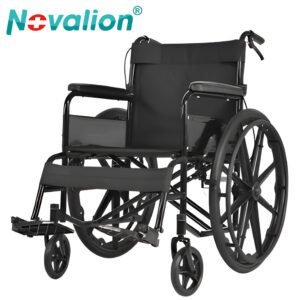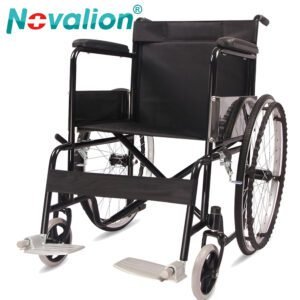Wheelchair with Off Road Tires: 5 Key Questions Answered—From Tire Specs to Terrain Performance & User Fit
For wheelchair users, rough terrain—whether a gravel driveway, grassy park, or wooded trail—can feel like an insurmountable barrier. Enter the wheelchair with off road tires: a design built to turn “no-go” zones into accessible adventures. But what makes these tires different, and how do they perform in real outdoor scenarios? Here are 5 critical questions answered to help you embrace the great outdoors.
1. What Defines a Wheelchair with Off Road Tires?
This specialized wheelchair is engineered to conquer unpaved surfaces, with tires as its standout feature. Key traits include:
- Tire Size: 12–24 inches in diameter (larger than standard wheelchair tires, which max out at 16 inches). This extra size increases ground clearance (3–6 inches), preventing the frame from scraping rocks or roots.
- Overall Design: Sturdy frames (steel or reinforced aluminum) to withstand impacts, wider wheelbases (30+ inches) for stability on slopes, and often enhanced suspension to smooth bumps.
- Key Difference from Standard Wheelchairs: Standard tires (8–16 inches, shallow tread) struggle on grass or gravel, sinking or slipping. Off road tires use aggressive treads and larger sizes to grip and glide over uneven ground.
2. What Makes Off Road Tires Suitable for Rough Terrain?
The tires themselves are the star, with features tailored to off-road challenges:
- Tread Patterns: Deep, angular grooves (3–5mm deep) act like “claws” to dig into mud, gravel, or grass. Some models have staggered lugs (rubber projections) to channel water or mud away, maintaining traction.
Tire Types:
- Pneumatic (Air-Filled): Offer shock absorption, smoothing bumps on trails. Best for users prioritizing comfort, though they risk punctures (carry a repair kit).
- Solid Rubber: Puncture-proof and low-maintenance, ideal for rocky terrain or users who hate flats. Trade-off: Less cushioning on rough ground.
Rim Reinforcements: Steel rims (heavier) or aluminum alloys (lighter) resist bending when hitting curbs or rocks. Bead locks (on premium models) clamp the tire to the rim, preventing slippage during intense use.
3. Who Benefits Most from This Wheelchair?
It’s a game-changer for users who refuse to let terrain limit their lives:
- Outdoor Enthusiasts: Hikers, campers, or bird-watchers wanting to access trails, forests, or beaches that standard wheelchairs can’t reach.
- Rural Dwellers: Those living on farms, dirt roads, or properties with unpaved driveways—where standard tires sink or get stuck in mud.
- Winter/Snow Users: Tires with deep treads (or optional chains) handle slush and light snow better than standard models, extending mobility into cold months.
- Active Urbanites: Even city dwellers benefit—navigating park trails, festival fields, or construction zones with ease.
4. How Does It Perform on Different Off-Road Surfaces?
Its versatility shines across diverse terrain:
- Grass & Lawns: Larger tires distribute weight to avoid sinking into soft soil. Treads grip uneven patches (e.g., mole hills) without sliding, making backyard barbecues or park picnics accessible.
- Gravel & Rocks: Reinforced rims and thick rubber resist punctures from sharp stones. Deep treads “bite” into loose gravel, preventing the wheelchair from skidding downhill.
- Mud & Wet Ground: Aggressive treads channel mud away from the tire, maintaining traction. Wider tires (3–4 inches wide) “float” over soft mud instead of sinking.
- Trails & Hills: Pneumatic tires absorb bumps from tree roots or rocks, while stable wheelbases (30+ inches) prevent tipping on slopes up to 15° (steeper inclines may need a caregiver’s help).
5. Ce qu'il faut prendre en compte lors de l'achat
- Tire Type: Choose pneumatic for comfort on trails or solid rubber for low maintenance (great for rocky areas).
- Maneuverability vs. Size: Larger tires (24 inches) handle rough terrain better but require wider turns. For tight trails, opt for 16–20 inch tires with a 32–36 inch turning radius.
- Poids: Off road wheelchairs weigh 50–80 lbs (heavier than standard models). Ensure caregivers can lift/load it if needed, or look for foldable designs (bulkier but transportable).
- Budget: Manual models start at $800; powered off road wheelchairs (with motors for steep terrain) range from $3,000–$8,000.
- Weather Resistance: Look for rust-resistant frames (aluminum) and waterproof upholstery if using in rain or snow.
Conclusion
A wheelchair with off road tires isn’t just about traversing rough ground—it’s about reclaiming freedom. Whether you’re exploring a forest trail, tending to a garden, or simply navigating a gravel driveway, these designs turn barriers into opportunities. By prioritizing tire type, durability, and your outdoor goals, you’ll find a wheelchair that keeps up with your adventures.
Merci d'avoir lu ces lignes. Si vous avez des suggestions à faire sur les sujets suivants notre site web ou souhaitez en savoir plus sur les fauteuils roulants, veuillez nous contacter. Nous répondrons rapidement.



